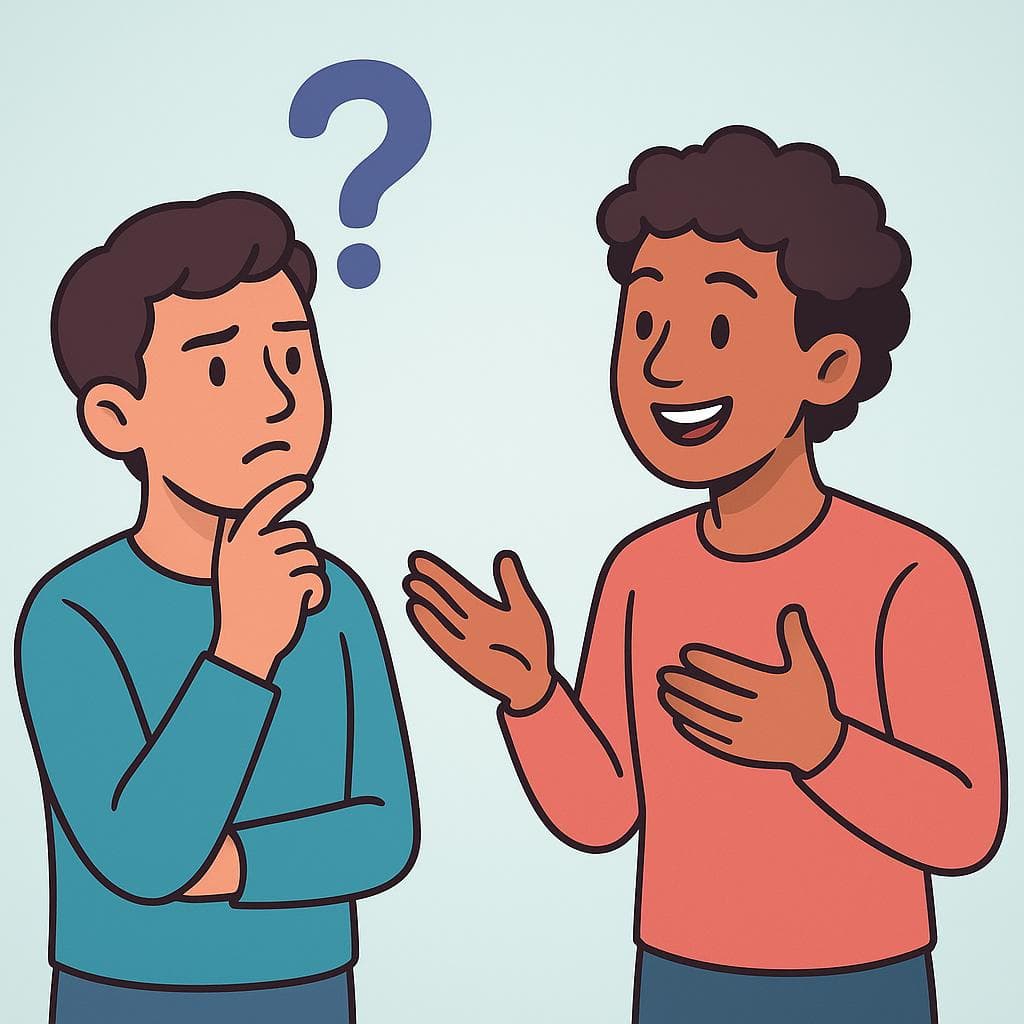What do you mean?
in Spanish¿Qué quieres decir?
/keh KYEH-rehs deh-SEER/
This is the most direct and common way to ask 'What do you mean?' to a single person you're familiar with, like a friend, family member, or peer.

When you don't understand, a simple '¿Qué quieres decir?' is the perfect way to ask for clarification.
💬Other Ways to Say It
¿Qué quiere decir (usted)?
/keh KYEH-reh deh-SEER (oos-TED)/
This is the formal version of the primary phrase, used when addressing someone with respect (usted), such as an elder, a boss, or a stranger.
¿Qué significa eso?
/keh seeg-nee-FEE-kah EH-soh/
Literally 'What does that mean?', this version is less personal. It focuses on clarifying a statement, idea, or situation rather than questioning the speaker's intention.
¿A qué te refieres?
/ah keh teh rreh-FYEH-rehs/
This translates to 'What are you referring to?'. It's a slightly softer and more specific way to ask for clarification, focusing on a particular point someone made.
¿A qué se refiere (usted)?
/ah keh seh rreh-FYEH-reh (oos-TED)/
The formal version of '¿A qué te refieres?'. Use this when speaking to someone you would address with 'usted'.
¿Cómo que...?
/KOH-moh keh.../
This isn't a direct translation but captures the feeling of 'What do you mean...?!' when expressing surprise, disbelief, or challenging a statement. You complete the phrase with what you're shocked about.
¿Qué quieren decir?
/keh KYEH-rehn deh-SEER/
This is the plural form, asking 'What do you all mean?'. In Latin America, it's used for any group of people. In Spain, it's the formal plural (ustedes).
¿Qué queréis decir?
/keh keh-RACE deh-SEER/
This is the informal plural form used in Spain (vosotros). It's used to ask 'What do you all mean?' to a group of friends, family, or peers.
🔑Key Words
Key Words to learn:
📊Quick Comparison
Choosing the right phrase depends on whether you're questioning the person, the idea, or a specific point. Here’s a quick comparison:
| Phrase | Formality | Best For | Avoid When |
|---|---|---|---|
| ¿Qué quieres/quiere decir? | Informal/Formal | Directly asking a person to clarify their own words or intention. | You want to sound less confrontational or are discussing an abstract concept. |
| ¿Qué significa eso? | Neutral | Asking for the definition of a word, symbol, or statement. It's impersonal and safe. | You specifically need to know what the *person* intended, not just what the words mean. |
| ¿A qué te/se refieres? | Informal/Formal | Pinpointing a specific, vague part of a conversation. It's polite and precise. | You are confused about the entire topic, not just one specific part. |
📈Difficulty Level
Fairly easy. The main challenge for beginners is the soft 'd' in 'decir' and the single-tap 'r' in 'quieres', but the sounds are generally familiar.
The main grammatical hurdle is remembering to switch between the informal 'quieres' (tú) and the formal 'quiere' (usted) depending on who you're talking to.
High nuance. Tone of voice is crucial to avoid sounding aggressive. Knowing when to use a more indirect alternative like '¿A qué te refieres?' is a key social skill.
Key Challenges:
- Choosing between formal (quiere) and informal (quieres)
- Controlling tone to avoid sounding confrontational
- Knowing when to use 'querer decir' vs. 'significar'
💡Examples in Action
Dijiste que el proyecto es 'complicado'. ¿Qué quieres decir exactamente?
You said the project is 'complicated'. What do you mean exactly?
Disculpe, profesor. Mencionó que el examen será 'diferente'. ¿A qué se refiere con eso?
Excuse me, professor. You mentioned the exam will be 'different'. What do you mean by that?
—No voy a poder ir a tu casa esta noche. —¡¿Cómo que no vienes?! ¡Te he estado esperando!
—I'm not going to be able to go to your house tonight. —What do you mean you're not coming?! I've been waiting for you!
Veo un círculo rojo en el calendario. ¿Qué significa eso?
I see a red circle on the calendar. What does that mean?
🌍Cultural Context
Directness and Tone
In many Spanish-speaking cultures, asking '¿Qué quieres decir?' is perfectly normal and not considered rude. However, like in English, your tone of voice is critical. Said with a sharp, aggressive tone, it can sound accusatory. A curious, gentle tone is key to making it a simple request for clarification.
Person vs. Idea
Choosing between '¿Qué quieres decir?' and '¿Qué significa eso?' is a subtle but important social skill. The first focuses on the person's intention ('What do *you* want to say?'), while the second focuses on the idea itself ('What does *that* mean?'). When in doubt, '¿Qué significa eso?' can feel a little safer and less personal.
The Importance of Tú vs. Usted
The distinction between the informal 'quieres' (for 'tú') and the formal 'quiere' (for 'usted') is a fundamental part of showing respect in Spanish. Using the wrong one can be awkward. Always default to the formal '¿Qué quiere decir usted?' with strangers, elders, and authority figures.
❌ Common Pitfalls
Confusing 'Mean' (Signify) with 'Mean' (Unkind)
Mistake: "Using the word 'malo' or 'tacaño'. For example, asking '¿Qué eres malo?'"
Correction: ¿Qué quieres decir?
Forgetting Formality
Mistake: "Saying '¿Qué quieres decir?' to your new boss or an elderly stranger."
Correction: ¿Qué quiere decir usted?
Incorrect Verb Combination
Mistake: "Asking '¿Qué quieres significar?'"
Correction: ¿Qué quieres decir?' or '¿Qué significa eso?'
💡Pro Tips
Soften Your Question
To ensure you sound polite, especially in a formal context, you can add a softener before the question. Phrases like 'Perdón, ¿qué quiere decir?' ('Excuse me, what do you mean?') or 'Disculpe, no entendí bien...' ('Pardon me, I didn't quite understand...') make your request for clarification gentler.
Use 'O sea' to Paraphrase
A great way to confirm your understanding is to rephrase what you think they meant. You can use 'O sea...' (meaning 'In other words...' or 'So...') followed by your interpretation. For example: 'O sea, ¿quieres decir que la reunión es mañana?' ('So, you mean the meeting is tomorrow?').
Choose '¿A qué te refieres?' for Specificity
When a conversation has multiple parts and you're confused about just one, '¿A qué te refieres?' ('What are you referring to?') is the perfect tool. It helps narrow the focus and shows you were listening but just need clarification on a specific detail.
🗺️Regional Variations
Spain
The most notable feature is the use of 'vosotros' for informal plural, making '¿Qué queréis decir?' very common among friends. The expression '¿Qué me estás contando?' is a frequent, colloquial way to express disbelief, similar to 'You've got to be kidding me!' or 'What do you mean?!'.
Mexico
Mexicans might use the slightly more indirect '¿Cómo está eso?' ('How is that?') as a polite way to ask for clarification. The slang phrase '¿Qué onda con eso?' ('What's the deal with that?') is a very informal way to ask what something means in a casual context.
Argentina
Argentina, along with Uruguay and some other areas, uses the 'voseo' form. This means 'tú quieres' becomes 'vos querés', and 'tú te refieres' becomes 'vos te referís'. This is the standard informal way to speak, so using the 'tú' form can sound foreign or overly formal.
📱Texting & Social Media
¿Qué quieres decir?
WhatsApp, social media comments, text messages.
dijiste q venias mas tarde, q quieres decir?
you said you were coming later, what do you mean?
¿Cómo?
Quick texts when you didn't understand something.
—nos vemos en el coso. —como? q coso?
—see you at the thingy. —what? what thingy?
💬What Comes Next?
After you ask '¿Qué quieres decir?'
Quiero decir que...
I mean that...
Ah, ya entiendo. Gracias.
Ah, now I understand. Thanks.
You still don't understand their explanation.
¿Me explico?
Do I make myself clear?
Lo siento, sigo sin entender.
I'm sorry, I still don't understand.
You want to offer your interpretation.
Es un poco confuso.
It's a bit confusing.
O sea, ¿estás diciendo que el plan cambió?
In other words, are you saying the plan changed?
🧠Memory Tricks
This direct link between the Spanish words and a similar English phrase makes it easy to remember the core structure.
🔄How It Differs from English
The biggest difference is that English uses the single verb 'to mean' for multiple concepts, whereas Spanish uses different verbs and constructions. Spanish requires you to distinguish between a person's intention ('querer decir') and an object's definition ('significar'). Furthermore, English often uses more indirect phrases like 'I'm not quite following' or 'Could you elaborate?', while a direct '¿Qué quieres decir?' is more common and acceptable in Spanish, provided the tone is right.
Spanish can be more direct. While 'What do you mean?' can sound confrontational in English depending on the context, '¿Qué quieres decir?' is a more standard, neutral tool for clarification in Spanish. English speakers often add more softening words ('I'm just a little confused about...', 'Sorry, I'm not sure what you mean by...') than are strictly necessary in Spanish.
False Friends & Common Confusions:
Why it's different: This uses 'mean' to describe a personality trait (unkind). Translating this concept into Spanish requires an adjective, not the verb 'querer decir'.
Use instead: To say someone is unkind, you would say 'Él es malo' or 'Él es antipático'.
🎯Your Learning Path
➡️ Learn Next:
How to say I don't understand
This is the most common reason you'd need to ask 'What do you mean?', so it's a natural pairing.
How to say Can you repeat that?
Another essential phrase for clarification when you didn't hear or understand something the first time.
How to say In other words
Learning 'o sea' helps you confirm your understanding and is a common way Spanish speakers clarify themselves.
How to say For example
After asking for clarification, you might ask for an example using 'por ejemplo' to better grasp the concept.
✏️Test Your Knowledge
💡 Quick Quiz: What do you mean?
Question 1 of 3
You are in a meeting and your new boss says something you don't understand. How do you politely ask for clarification?
Frequently Asked Questions
Is it rude to say '¿Qué quieres decir?' in Spanish?
Not inherently, no. It's a very common and direct way to ask for clarification. However, your tone of voice is crucial. If you say it with a sharp or accusatory tone, it can sound rude, just like in English. With a neutral, curious tone, it's perfectly polite.
What's the real difference between '¿Qué quieres decir?' and '¿Qué significa eso?'
Think of it as 'person vs. thing'. '¿Qué quieres decir?' asks about the person's intention or what they are trying to communicate. '¿Qué significa eso?' asks about the objective meaning of a word, a sign, or a statement. When in doubt, '¿Qué significa eso?' is often a safer, more neutral choice.
How do I ask 'What do you mean?' to a group of people?
In most of Latin America, you would say '¿Qué quieren decir?'. In Spain, you would use '¿Qué queréis decir?' for an informal group (friends) and '¿Qué quieren decir?' for a formal group.
What's a more polite or softer way to ask for clarification?
A great polite alternative is '¿A qué te refieres?' (informal) or '¿A qué se refiere?' (formal), which means 'What are you referring to?'. You can also add softeners like 'Perdona, no entendí muy bien...' ('Sorry, I didn't quite understand...').
If someone asks me '¿Qué quieres decir?', how do I answer?
You can start your explanation with 'Quiero decir que...' which means 'I mean that...'. For example, 'Quiero decir que llegaré un poco tarde.' ('I mean that I will arrive a little late.'). Another very common way to start is with 'O sea...' ('In other words...').
Can I just say '¿Cómo?'
Yes, but be careful. '¿Cómo?' can mean 'What?' as in 'I didn't hear you'. If you want to say 'What do you mean?', it can work in very informal contexts, but it can also sound a bit abrupt. It's better to use a full phrase unless you're in a very casual chat.
📚Continue Learning Spanish Phrases
Explore More Phrases in These Categories
Find similar phrases to expand your Spanish vocabulary:
Want to Learn More Spanish Phrases?
Browse our complete collection of Spanish phrases organized by situation, from basic greetings to advanced conversations. Perfect for travelers, students, and anyone learning Spanish.
View All Spanish Phrases →

